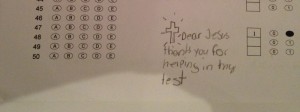California has instituted a new state test based on the Common Core. Results are in and results were predictable, in my view. Scores fell as scores are beginning to fall across the country. If we keep making the tests harder, scores will go down. I’d suggest that’s common sense, although I am afraid that if I do, someone will demand my research. Common sense doesn’t get much respect nowadays.
I would like readers to follow me down my path, starting by reading the following article:
http://www.latimes.com/local/lanow/la-me-ln-achievement-gaps-widen-20150911-story.html, although the below quote on the new test’s results covers the issue that spawned this post. The article’s a good read if you have time. If not, fine.
“This is going to show the real achievement gap,” said Chris Minnich, executive director of the Council of Chief State School Officers. “We are asking more out of our kids and I think that’s a good thing.”
At the same time, he added, “there’s no question that when we raised the bar for students that we’re going to have to support our lower-achieving students even more so than we are now.”
Although scores declined for all students, blacks and Latinos saw significantly greater drops than whites and Asians, widening the already large gap that was evident in results from earlier years, according to a Times analysis.
Under the previous test, last given to public school students two years ago, the gap separating Asian and black students was 35 percentage points in English. The gap increased to 44 percentage points under the new test. Asian students’ results dropped the least on the new tests, which widened the gap between them and those who are white, black or Latino, the analysis showed.
White students also maintained higher relative scores than their black and Latino peers.
A similar pattern occurred with students from low-income families. Their scores in math, for example, declined at a steeper rate (51%) than those of students from more affluent backgrounds (16%). In the last decade, all ethnic groups made significant academic gains compared to where their scores started. But the gap separating the scores of blacks and Latinos from whites and Asians changed little.
Eduhonesty: This widened gap between subgroups taking our standardized tests does not surprise me. When we make the test harder, some of those kids who are already at a disadvantage will fall farther than academically stronger counterparts. Why? I’m sure there are many factors, but one leaps out at me immediately. In the classroom, on harder tests, some kids at the bottom tend to give up. Many adolescents especially will quit working if they don’t believe they can succeed. If they think they might manage to get lucky by eliminating one or two wrong answers on each question, they often hang in, hoping to reason/luck their way into a decent grade. But at a certain level of difficulty — at the point where they don’t believe they can identify most or any wrong answers — students begin guessing without trying.
In a nutshell, as the test gets harder, stronger students begin to have to eliminate answers and guess between what remains, while weaker students lose that ability to eliminate answers and begin to do almost nothing except guess. This one fact explains the widening gap. The stronger students may be missing more problems as they eliminate wrong answers and then choose between what remains. But those students will get more right than students who are purely guessing. I know this guessing happens. One big clue: When a student fills in 50 bubbles on a 40 question section.
The much larger issue here of racial and income inequities I will have to save for later. Those inequities are a book, not a blog post. They are also proving remarkably resistant to attempts to level the academic playing field.

